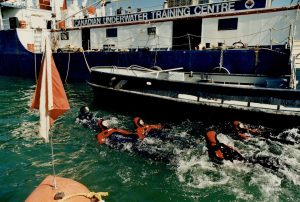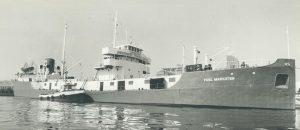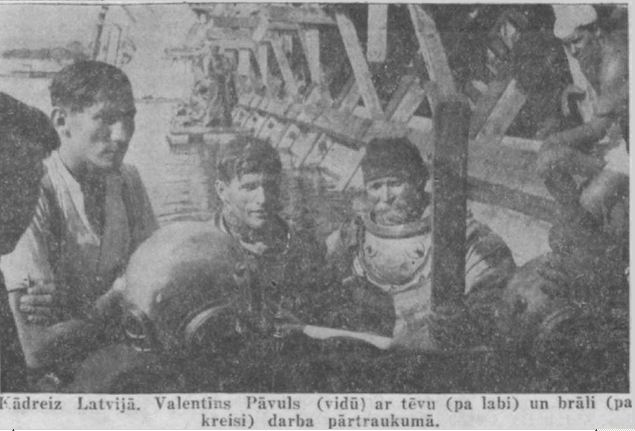Valentine Pavuls (17.09.1905- 14.02.1993)
Valentin Pavuls was born in 1905. on September 17 in Vecauce, but he lived his life by the waters or in the water itself - working as a diver. To ensure a practical life, he turned to the risky job of a diver already in Latvia. Until 1914, the Pavulus family lived in Ķipsala near the Daugava, in that year, because of the war, they had to move to Northern Russia near the Ladoga and Onega lakes, where they survived the war and the revolution.
In 1922, after returning to Latvia, he had to start life anew.— While working during the day, V. Pāvuls managed to graduate from the evening secondary school of the Society for the Promotion of Latvian Culture and enter the chemistry faculty of the university, start a career as a diver and found his own family (wife Hermīne Kreicmane, son Valentine and daughter - Laila). While working at the Ķegum power station, he also had time to practice painting, which he later paid more serious attention to in Sweden and Canada, and writing, submitting articles to Younger News and Leisure.
In 1944, when the Russians invaded Latvia for the second time, Pāvuls, along with his family and over ten other refugees, crossed over to Sweden in a boat, dragging another boat across the sea. Lived in Sweden for eight years, working at a small power plant, blowing up sunken ships in the Baltic Sea and painting. During this time, the family grew with the addition of a son, Andri. While working on the construction of the Ķegum power plant, he met several Swedish engineers, and when he fled to Sweden with his family, this acquaintance turned out to be important. In Sweden, Pāvuls began to focus more seriously on art and paint what he saw both above and below the water, bringing a new theme to Latvian painting.
In 1952, Pavel moved to Canada, where he worked as a diver, mostly in the Canadian Dredge company.
Here we start a series of articles on Latvian divers history. Let's preserve the history of Latvian underwater sports! We invite Latvian underwater sports veterans or people who know underwater athletes or port divers to apply. Excerpts from the records of M. Derum in 1952.
This is Ķīpsala, where mainly captains, salmon fishermen and anchors lived, and Valentina's childhood years passed on the Daugava, and here he learned to love the smell of wind and tar, from an early age he got used to living on the water and working hard.
In his youth, Valentine imagined life as a process driven by man himself, as the captain of a ship. Therefore, the will must be exercised. And the young man sat for hours in front of a plaster figure, looking at its nose and inspiring itself to do good works; did five things he did not like every day and did not do five things he liked: he stood on his head and would have sat on his nails just to develop his will. His dream was to become a chemist. Valentin finished the evening high school in a year and a half and after entering the university he entered the university, but when his funds ran out, he made money on ships and in various jobs again. Here it was mainly the case that led V. Pāvuls to the course of the diver.
Old Paul, who had previously worked to lift sunken tugs, undertook to lift an acquaintance's sailor who had sunk in the sea during the autumn storms. "Kaija”With narrow gauge rail freight. When the negotiated divers did not arrive at the last minute, the father decided - let's do it ourselves! But when the father's and eldest son's diving attempts failed, it was Valentine's turn. Either the former will exercises with plaster figures or something else helped - but he succeeded! And Valentina Paul's life had taken a different direction.
It was in the summer of 25 years ago in the Baltic Sea near Ģipka, when the next diver first got to see the bottom "from the inside". After trying on the diving suit first sitting on the embankment on the embankment, he dived at the beginning to a depth of 3 meters: white sea sand below, greenish overhead, a sun-drenched veil. The small transparent flock sought refuge in fear under a heavy lead boot. Later, at a depth of 22 meters, in a thick chair, fingering around the sunken sailboat, walling the first knot and finding the first corpse, the picture was less romantic, but in this knot Valentīns Pāvuls had also sown his future.
Here he also learned another important commandment: to deal with everything alone under water.
Paul loved the new work, and although it always takes place in similar circumstances, something new always comes. Once upon a time, it was a North Pole expedition ship sunk near Daugavgrīva. "Nordenskjoeld ”, other times a tug, bridge construction, broken anchor, lost drowning, or 1 Swedish time cannon ball fishing on the Daugava near Krustpils.
Pāvuls remembers with particular fondness the “expedition” organized by the School Museum - a collection trip of exhibits along the Daugava, in which he participated as the 13th participant in a lice that lasted 13 days. Mention should also be made of the search for torpedoes lost in naval maneuvers during naval service, where Paul was still learning this and trying to play chess from the seabed.
All these variegated lines come to an end - Ķegums, where several other Latvian divers worked in the construction of the power plant, including the old Pāvuls. Here it was possible not only to gain a lot of new knowledge and experience, but also to find new, improved work methods and earn a lot. There came both times of occupation, when it was more pleasant to dive under water and not see what was happening all around. Paul's last job in Latvia with his father was in 1944. near Ventspils, looking for someone
sunken warships. There was also an opportunity to flee to Gotland in two motorboats, taking other Latvians with them.
In Sweden, too, V. Pāvuls operates in his field, because already during the construction of Ķegums he had established contacts with some Swedish companies. The Swedish stage is as experienced as all the previous ones. Notable work with a steamer "Ostpreussen'Which, together with two other German transport vessels, sailed in the Swedish minefields during the war. A total of 212 soldiers ended up, and a myriad of ammunition sank. Of that, 6 tons of Paul released into the air with a charge of 50 kg of dynamite! It was an experience similar to the explosion of a miniature atomic bomb at sea, except that the noise before the water mushroom took off was no louder than the impact of a hammer. The sea was then 1 km white with dead cod. The last job in Sweden was with the former Latvian steamer "Vizma"Which the Danes had shaken as"Runo“.
In total, Valentīns Pāvuls participated in the lifting or blasting of 36 ships and ferries, in the construction of 7 stations and 3 bridges, in the construction of 9 blown bridges, and in the reconstruction of 3 ports.
V. Pāvuls has also been involved in public work, leading in 1933. established divers 'association, .Dzelme ”and even organizing divers' competitions in Lielupe. His first public speech came out of his colleague Contant. The continent died at a depth of 32 meters, entangled in the driveways and trying to get rid of them, straining the heart.
Pavuls himself was once in such danger for 2 hours on the already mentioned "Nordenskjoold", But signaled to the worried members upstairs all the time: everything was fine, did not lose his nerves and finally got rid of it.
Good health, endurance and nerves in general are what a diver needs. In the past, it was still required for a diver to be able to lift 10 puddles, but such requirements have long been out of fashion.
Let's preserve the history of Latvian underwater sports! We invite Latvian underwater sports veterans or people who know underwater athletes and former divers to apply.
Valentīns Pāvuls creates a diver training school "Canadian Underwater Training Centre"
The Toronto Latvian was often mentioned in the Canadian press in 1979 Valentine Pavula name, due to his newly founded first diving school in Toronto, operating on the shores of Lake Ontario.

The new school is known by the name "Canadian Underwater Training Centre". It is installed in its original form on a former Shell company oil carrier, which is now moored east of the Harbor forecourt. The big ship, which was rebuilt for the needs of the new school, can already be seen for a large distance with its red and blue chimney and about 90 m long. The large tanks in the reservoirs, where oil used to be, now contain water in which divers practice their craft. The former sailors' sleeping quarters are now divided into classrooms, and the captain's quarters have become V. Pávila's office.

He stops for a moment by his diving apparatus and invites you to take a small tour of this training center.
In recent years, the demand for professional divers has been very high, as many international ship and oil exploration companies have expanded their operations to cover all types of construction work under
water. All such construction works and constructions require divers who not only know their trade, but are also able to perform other jobs, such as, for example, welding, etc. had to invest a million dollars. large capital stock.” This money comes from the diving company "Forand Marine and Construction Co." managed by V. Pāvulas. Ltd.” In order to start the work of the new school, various divers' and divers' accessories were needed. In order for a diver to start his work, he has to count on 7000 dol. big expenses. For example, a diver's helmet or headgear alone costs around 4,500 dollars, a suit costs 700 dollars. and telephone equipment $1,500, not including compressed air tanks and other accessories.

Valentin Pāvuls started the school with 25 students, and their number is increasing every week, although one course costs about 2300 dollars for each student. this is the so-called basic course for divers, which lasts 15 weeks, during which the student acquires the necessary knowledge of his trade, but later he can work in practice - working under water up to a depth of 200 feet. Currently, V. Pāvula's students do not descend deeper than 70 feet. When asked who trains young divers, V. Pāvuls answers with a smile: "Fortunately, I have attracted 5 instructors who have a lot of experience in this industry." In a further conversation, V. Pāvuls, who got his diver's license from his father Valentin (senior), explains: "Anyone who has reached the age of 18 or is not older than 40, with good health and some prior knowledge in mechanics or constructions can study at the new school. But most importantly, you need an interest in the diver's profession."
"Successful cadets will not have to worry about job opportunities," adds Valentin, who has been working in this industry for years. There is a shortage of good divers not only in Canada, but all over the world. Those who choose this profession can earn around 25,000 dol. per year."
On September 4, the school started its activities with the already mentioned 25 students, but on October 1, the second course began with the same number of interested students. The next, larger course, starting in January, will also cover underwater photography. V. Pavul expects that the school he leads with the support of the Ontario government will have a successful future. This optimistic view is evidenced by the 10-year contract signed with the port administration.
When asked about the safety rules and enemas that could happen in this industry, V. Pāvuls says: "The diving profession is no more dangerous than, for example, flying or driving a car. Misfortunes, of course
cases happen now and then, Of course, you should always be careful, because it is precisely because of carelessness that various accidents occur, which can also claim life. Working underwater as such is not dangerous. In twelve years
I haven't experienced any enemas, nor have I heard that one of my colleagues was injured in an accident." Valentina Pāvul's interest in this profession arose as a boy, under the influence of his father. Already in Latvia, his father was a well-known diver and continued his work in Sweden. It was there that the son became interested in his father's profession, even though he reserved some of his time for chemistry and surveying.
By 1958, the young Valentine had already acquired so much knowledge that he joined the work at St. for the Lorenz Waterway projects. It should be mentioned here that his father's "Marine Construction" company was already well established at that time.
In conclusion (let's mention that CBC television will soon broadcast a special program in which V. Pāvula's divers' school will dominate.
Participate in the creation of the divers' museum
At the moment, the collection of the "Waterskiing Museum" exposition is taking place, if you want to participate in its creation, the place of creation of the collection is Pinki, Mārupe district, LV-2107, phone 220-77-202.
All supporters who help in creating the collection will be entered in the list of honored guests of the "Diving Museum" and will receive a gift card for diving club services.

